Resilience depends on ecosystems as much as on concrete.
Grey to green: Why nature must move from margin to the mainstream

A man waters a tree planted on the edge of the Gobi desert on the outskirts of Wuwei, Gansu province, China, April 15, 2021. REUTERS/Carlos Garcia Rawlins
Ahead of COP30, the message is clear - we must value ecosystems properly and design infrastructure so that it works with nature.
Erik Berglöf is Chief Economist at the Asian Infrastructure Investment Bank (AIIB).
For more than two centuries, the dominant approach to building infrastructure has been “grey”: roads, bridges, dams, and grids. This model enabled rapid growth and raised living standards for millions.
It also contributed – often unintentionally – to widespread ecological degradation. As climate and nature risks intensify, the case for complementing grey assets with “green” solutions and ultimately shifting to using nature as essential infrastructure is no longer niche policy – it is prudent economics.
The World Meteorological Organization’s latest water report notes that only about a third of monitored river basins had normal conditions in 2024, the hottest year on record.
With COP30 in Brazil approaching, the Amazon Basin – home to roughly a tenth of global biodiversity and an important source of moisture for large parts of the world – has faced severe drought.
These trends underscore a simple point: resilience depends on ecosystems as much as on concrete.
By viewing nature as infrastructure, we are encouraged to identify and value all the benefits it provides. Wetlands act as a buffer against rising floodwaters, capture carbon, purify air and water, help cross-pollination, provide recreation and so much more. Well-managed mangroves and healthy forests also provide many benefits. And so on. When these natural systems are eroded, grey infrastructure must work harder and costs more.
Historically, economic models have struggled to capture nature’s full value, and biodiversity has not always been integrated into project design, tilting investments to near-term outputs rather than long-term resilience.
Yet there are practical examples of a better approach.
Launched in 1978, China’s ambitious Great Green Wall – or to give it its official title, Three-North Shelterbelt Program – aimed to prevent two vast deserts from merging by restoring vegetation.
Originally poorly conceived, the project evolved and now the forest cover in targeted areas has increased substantially and extends across large parts of the north. Evidence points to multiple benefits: improved ecosystem services, greater carbon sequestration, and fewer dust storms.
It is a large-scale initiative, but the underlying principles – long-horizon planning, ecological restoration based on science and community engagement – are highly adaptable to smaller settings.
We must value natural capital
But natural capital remains undervalued, and the result is under-investment: ecosystem assets that underpin water security, agricultural productivity and disaster protection often lack defined revenue streams and struggle to attract finance.
AIIB’s Nature as Infrastructure report looks at how projects designed to work with nature reduce lifetime costs and raise resilience. It also maps scalable instruments – from guarantees to results-linked finance – that can bring in private capital.
Increasingly, we see the development of new tools to improve how nature is assessed and integrated into decisions.
The Natural Capital Valuation Model, originally developed by Arcadis and the European Bank for Reconstruction and Development, helps identify nature-related risks and enhancements at the project level, guiding more “nature-positive” choices.
Wider adoption of such methodologies – alongside emerging disclosure standards – can show policymakers, investors and communities, why and how nature is valuable.
Finance innovation is equally important.
Sustainability-linked bonds can tie borrowing costs to measurable ecological outcomes. Debt-for-nature swaps can free fiscal space for conservation where debt burdens are heavy.
We cannot meet development and climate objectives without placing nature at the core of infrastructure plans.
Biodiversity credits may create transparent markets for ecosystem restoration and stewardship. None of these instruments is a silver bullet, but collectively they expand the menu of options to fund nature as infrastructure.
Blended finance can help bridge the risk-return gap. When concessional public or philanthropic funding is combined with private capital, it can de-risk early projects, bring in institutional investors, and build a pipeline at scale. Over time, as track records accumulate and policy frameworks mature, the need for concessionality should diminish.
Multilateral development banks (MDBs) have a distinct role. With their convening power, risk-sharing capabilities, and technical expertise, MDBs can develop common approaches, standardise disclosures, and help countries align national biodiversity strategies with the Kunming–Montreal Global Biodiversity Framework.
They can also mobilise private investment by expanding guarantees, supporting local-currency solutions, and co-financing projects that integrate nature from the outset. Crucially, MDBs can help governments embed nature into planning and budgeting.
Ahead of COP30 in Brazil, the message is practical rather than ideological.
We cannot meet development and climate objectives without placing nature at the core of infrastructure plans. That means valuing ecosystems properly, designing projects to work with nature, and scaling finance that rewards measurable outcomes. It also means learning from success – large and small – and adapting those lessons to local contexts.
Nature is not a constraint on development; it is an enabler of durable growth and resilience. Bringing it from the margin to the mainstream is, ultimately, about better economics.
Any views expressed in this opinion piece are those of the author and not of Context or the Thomson Reuters Foundation.
Related
Latest on Context
- 1
- 2
- 3
- 4
- 5
- 6
Most Read
- 1
- 2
- 3
- 4
- 5














